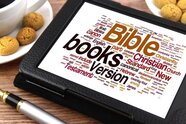Effective Use of the Bible in Faith Formation: Engage-Understand-Live

How does a catechist make the most effective use of the Bible? For our learners from child to adult to become disciples it is necessary that they read and come to know God/Jesus/Holy Spirit in the scriptures. To use the bible effectively for a lesson is to approach the words of the sacred text in a way that leads to understanding of the message a book’s author is trying to convey. By applying this simple three step approach Engage-Understand- Live each time we are praying or studying scripture will encompass being both attentive to the relationship with God as well as using scripture study tools to understand the message. This will make the scripture become a living source of faith.
Engage
Prayer is the initial way we approach a passage in scripture. Opening oneself to God’s movement in the passage makes it personal and relational. This can be done by using an approach like Lectio Divina or another prayer form that allows for reading the passage prayerfully. Questions to consider during this time are: Are there any words or phrases that I am drawn to? Is there anything that you are curious about? Is there anything that immediately challenges me? Some examples of prayer forms that use scripture as a basis for prayer.
Lectio Divina: A Beginner's Guide
Busted Halo
Praying With Scripture
ignationspirituality.com
Understand
Developing our relationship with God is the primary reason we read scripture, but that does not mean that we do not use our intellect to try to enter into the passage. Especially when we are doing faith formation we need to help our learners come to know that not everything that is read can be read from our current culture or read literally. The bible is a library of different types of literary writing all written in a given historical and cultural context. The message that is being conveyed becomes clearer when information that we don’t understand is made clearer through finding out the background. This is a good subject to explore by taking a course and coming to a better understanding of scripture study skills. But asking questions of the text and using footnotes in a study bible or a commentary written about the book of the bible enables one to realize a fuller sense of the meaning of a passage. What is happening in the passage-people, places, situation? Who is the author of the book and what is happening during the time in that community? What message is the author giving us? From a better understanding of the text we can then bring oneself to the text in prayer and move to what God is saying to me?
USCCB has all the books of the bible online. See “Introduction” for the commentary for each book.
The Bible project has videos for learning and viewing to be used in teaching
Reading the Bible
Strong Catholic Family Faith
Live
Once we have made the effort to Know the message of the passage, we return to our prayerful reflection from Pray. Now we can bring the passage to our own reflection in our everyday life circumstances or the situations of our parish, community and world. Some questions guide this reflection: What is God saying to me/us in this passage? How does this affect my/our life/lives? Do I need to make changes in my/our behavior, lifestyle, attitudes? Do I/we notice God calling me/us in a particular way?
Bible on Pinterest
RCFaithquest